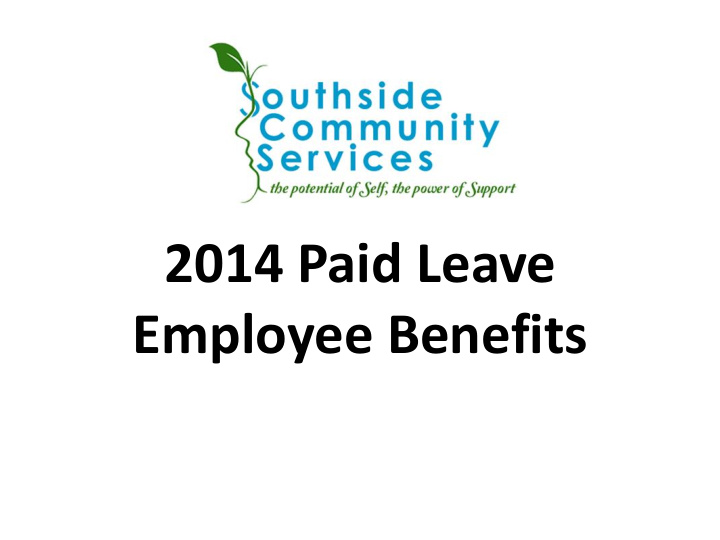



2014 Paid Leave Employee Benefits
Why We Changed Our Benefits Plan 1. Earlier this year the VA General Assembly legislated that the length of short-term disability (STD) for state and local government employees on 1/1/14 shall be increased from 13 to 26 weeks of paid leave. 2. VRS responded by creating a “Hybrid Plan” that forces all current participants to permanently opt in or out of their disability plan.
Why We Changed Our Benefits Plan 3. SCS’s present system of paid leave for ‘sick” time is incompatible and unsustainable with the 1/1/14 requirements. 4. Like many other CSBs, SCS opted to purchase STD and LTD coverage that was better for our current employees than that offered by the VRS “Hybrid Plan”. This also allows us to apply benefits fairly among all employees.
Why We Changed Our Benefits Plan 5. To maintain a coherent system of benefits for current employees and those hired after 1/1/14 (who may only participate in the Hybrid Plan), SCS is shifting to a Paid Time Off (PTO) system.
PTO Benefit • The purpose of Paid Time Off (PTO) is to provide employees with flexible paid time off from work that can be used for approved absences for any reason, such as vacation, illness, family illness, personal business, etc. • PTO replaces all annual leave and sick leave.
Paid Time Off Accrual Rates Full-time employees accrue paid time off according to this schedule: Years of Service Paid Time Off 0-4 Years 24 Days 5-9 Years 29 Days 10+ Years* 34 Days Up to 120 hours of paid time off can be carried forward into the next year. Any hours above the 120 allowed carryover at the end of the calendar year will be forfeited. * In acknowledgement of long-term employees who previously earned vacation time at 6 or 7 weeks per year, a salary adjustment of either 1 or 2 weeks pay at current hourly rate will be made to their annual salary.
Paid Time Off Accrual Rates Part-time employees accrue paid time off according to this schedule: Years of Service Paid Time Off 2-3 Years 8 Hours 3-4 Years 16 Hours 5+ Years 24 Hours • PTO must be used in minimum 8 hour increments. PTO remaining at the end of the calendar year will be forfeited. • Residential part-time employees may choose to take pay in lieu of time off in 1 hour increments at the current hourly pay rate.
How Will The PTO Benefit Work? • The established year for calculating earned paid time off for employees shall be from the employee’s date of hire. Paid time off that will be earned each pay period during the year will be available for use on January 1 st of that year. • Up to 120 hours of paid time off can be carried forward into the next year. Any hours above the 120 allowed carryover at the end of the year will be forfeited.
How Will We Transition to PTO? 1. Up to 120 hours of vacation earned through 12/31/13 will be applied to the starting 2014 PTO balance (312 hours/39 days max). Any earned hours above 120 and below 240 will be paid at the employee’s current hourly rate in a 1-time payment. • Per current policy, unused vacation above 240 hours may not be carried over and is forfeited. 2. Up to 120 of sick hours earned through 12/31/13 will be applied to the starting 2014 PTO balance if the maximum hours are not reached from vacation time. All remaining sick hours will be paid at 25% of the employee’s current hourly rate in a 1-time payment.
Recommend
More recommend